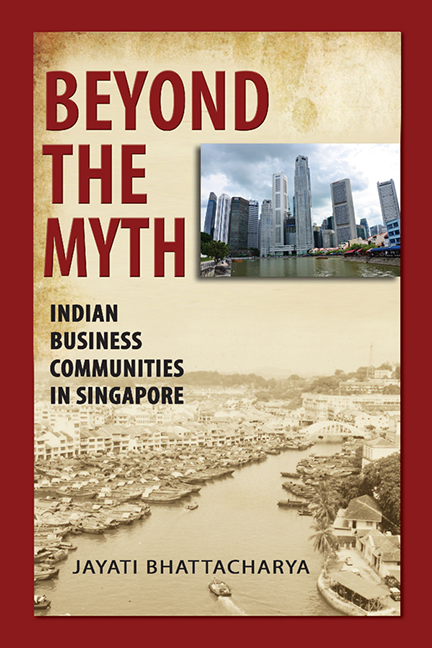Book contents
- Frontmatter
- Dedication
- Contents
- List of Map, Tables and Figures
- Message by Mr R. Narayanmohan
- Foreword by Professor Tan Tai Yong
- Message by Ambassador K. Kesavapany
- Acknowledgements
- List of Abbreviations
- Introduction
- PART ONE
- Chapter One Making Singapore their Homeland: The Early Indian Migrants to the Lion City
- Chapter Two The Post-Independence Period: Changing Dynamics and the Shift in Business Activities
- Chapter Three Taking Strides into the Future: Transition and Transformation of the Indian Business Communities
- PART TWO
- Conclusion: Surging Forward
- Appendices
- Select Bibliography
- Index
- About the Author
Chapter Two - The Post-Independence Period: Changing Dynamics and the Shift in Business Activities
from PART ONE
Published online by Cambridge University Press: 21 October 2015
- Frontmatter
- Dedication
- Contents
- List of Map, Tables and Figures
- Message by Mr R. Narayanmohan
- Foreword by Professor Tan Tai Yong
- Message by Ambassador K. Kesavapany
- Acknowledgements
- List of Abbreviations
- Introduction
- PART ONE
- Chapter One Making Singapore their Homeland: The Early Indian Migrants to the Lion City
- Chapter Two The Post-Independence Period: Changing Dynamics and the Shift in Business Activities
- Chapter Three Taking Strides into the Future: Transition and Transformation of the Indian Business Communities
- PART TWO
- Conclusion: Surging Forward
- Appendices
- Select Bibliography
- Index
- About the Author
Summary
In the different phases of Singapore's economic progression, the Indian business communities, like any other community, had been trying to negotiate its space and identity through fissions and fusions, inclusion and exclusion, and working out the nuances of religious, regional and ethno-cultural issues. In the continuous process of changing dynamics, the economic factors had been intimately related to other circumstantial elements. The Indian business communities in Singapore as in most of the other Southeast Asian states, evolved and restructured themselves in the post-colonial phase, and again in more recent trends of globalization. In the various stages of negotiation and evolution, enterprises went through their highs and lows, business changed hands and the character of the goods and commodities of trade altered. The ethnic Indian business groups, broadly categorized as North and South Indians, as we have seen in the previous chapter, gradually disseminated from the visible spatial architecture into the larger framework of the multiracial identity in the country. This chapter will focus on some of the challenges faced and diversification efforts of the different Indian business groups and individuals and their negotiations with the new vistas of modernization.
CHANGES AND CHALLENGES
Nation building and restructuring an independent Singapore had been a daunting task that the Singaporean leaders had undertaken in 1965 and accomplished with consummate success. The new trajectory was based on making the best of its geopolitical advantages, the foundations of which was already laid down by the colonial rulers; and at the same time implementing different facets of modernization in economic, social and political perspectives. Thus, on the one hand, Singapore became the busiest port of the Commonwealth by 1969, the container transhipment centre for Southeast Asia by 1972 and claimed to be the third important port in the world by 1975 only after Rotterdam and New York; on the other hand, Singapore invested in building up a modern armed force to protect itself and in development expenditure on infrastructure, building HDB estates for residences, improvising communication facilities and setting up of manufacturing units. Jurong was set up as an industrial estate and by the end of 1970 she had 264 factories with 32,000 workers which were in production and another 106 factories under construction.
- Type
- Chapter
- Information
- Beyond the MythIndian Business Communities in Singapore, pp. 91 - 138Publisher: ISEAS–Yusof Ishak InstitutePrint publication year: 2011



